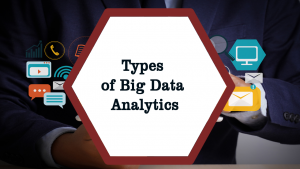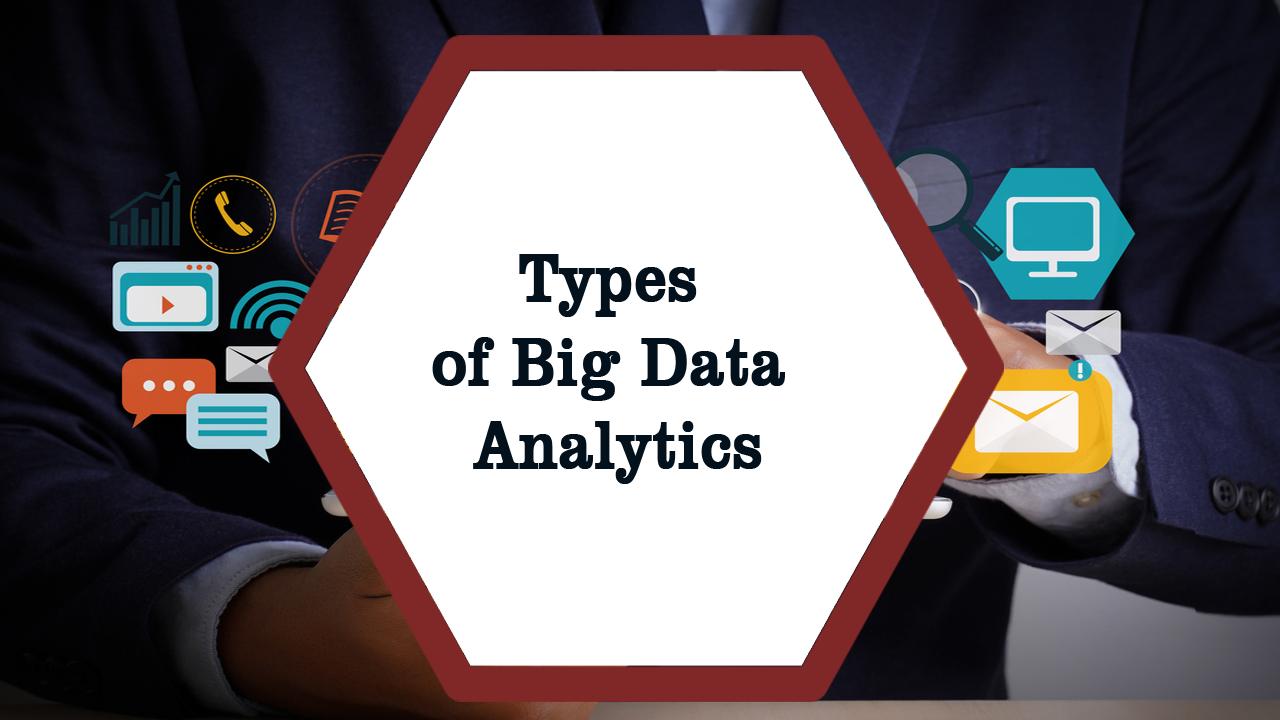Introduction Types of Big Data Analytics
Big Data Analytics is a process of analyzing and interpreting large and complex datasets to extract insights and make better business decisions. There are different types of Big Data Analytics that businesses and organizations use depending on their needs and goals. In this article, we will discuss the four types of Big Data Analytics: Descriptive Analytics, Diagnostic Analytics, Predictive Analytics, and Prescriptive Analytics. 
Descriptive Analytics Types of Big Data Analytics
Descriptive Analytics is the most basic type of Big Data Analytics. It involves analyzing historical data to understand what happened in the past. Descriptive Analytics answers the question of “what happened?” by summarizing and visualizing data in a way that is easy to understand. This type of analytics is useful for businesses to understand their current state and identify trends and patterns. Some examples of Descriptive Analytics include sales reports, website traffic analysis, and customer segmentation analysis.
Diagnostic Analytics Types of Big Data Analytics
Diagnostic Analytics is the next level of Big Data Analytics. It involves analyzing data to understand why something happened. Diagnostic Analytics answers the question of “why did it happen?” by identifying the root cause of a problem. This type of analytics is useful for businesses to identify areas where they can improve their processes and operations. Some examples of Diagnostic Analytics include customer churn analysis, root cause analysis, and A/B testing.
Predictive Analytics
Predictive Analytics is the type of Big Data Analytics that uses machine learning algorithms to make predictions about the future. Predictive Analytics answers the question of “what will happen?” by analyzing historical data and identifying patterns and trends. This type of analytics is useful for businesses to make data-driven decisions and take proactive measures. Some examples of Predictive Analytics include demand forecasting, predictive maintenance, and fraud detection.
Prescriptive Analytics
Prescriptive Analytics is the most advanced type of Big Data Analytics. It involves using machine learning algorithms to provide recommendations on what actions to take. Prescriptive Analytics answers the question of “what should we do?” by providing actionable insights that businesses can use to optimize their operations and achieve their goals. This type of analytics is useful for businesses to take data-driven actions that lead to better outcomes. Some examples of Prescriptive Analytics include inventory optimization, pricing optimization, and personalized marketing.
Choosing the Right Type of Big Data Analytics
Choosing the right type of Big Data Analytics depends on the business’s needs and goals. Descriptive Analytics is useful for businesses that need to understand their current state and identify trends and patterns. Diagnostic Analytics is useful for businesses that need to identify the root cause of a problem and improve their processes and operations. Predictive Analytics is useful for businesses that need to make data-driven decisions and take proactive measures. Prescriptive Analytics is useful for businesses that need to take data-driven actions that lead to better outcomes.
Conclusion Types of Big Data Analytics
In conclusion, there are four types of Big Data Analytics: Descriptive Analytics, Diagnostic Analytics, Predictive Analytics, and Prescriptive Analytics. Each type of analytics serves a different purpose and provides unique insights. Choosing the right type of Big Data Analytics depends on the business’s needs and goals. By using Big Data Analytics, businesses can gain valuable insights that lead to better decision-making and better business outcomes.
Choosing the Right Type of Big Data Analytics
In the world of big data, the sheer volume and complexity of data can be overwhelming. To extract meaningful insights and drive strategic decisions, it’s crucial to choose the right type of big data analytics. The effectiveness of your analytics approach can significantly impact the value you derive from your data. This article explores the different types of big data analytics and offers guidance on how to select the right approach for your needs.
1. Descriptive Analytics
Definition: Descriptive analytics focuses on summarizing historical data to understand what has happened. It provides insights into past events by aggregating and presenting data in various formats, such as reports, dashboards, and visualizations.
Applications:
- Business Performance Reports: Analyzing past sales data to understand performance trends.
- Customer Insights: Reviewing customer behavior patterns and demographics.
Choosing Descriptive Analytics When:
- You need to understand historical trends and patterns.
- Your goal is to generate reports and dashboards that provide a snapshot of past performance.
- You want to analyze and visualize data to make informed decisions based on historical data.
2. Diagnostic Analytics
Definition: Diagnostic analytics delves deeper into data to understand why certain events happened. It goes beyond summarizing past data by identifying relationships and correlations that explain the underlying causes of observed outcomes.
Applications:
- Root Cause Analysis: Investigating why sales declined during a specific period.
- Operational Issues: Understanding reasons behind supply chain disruptions.
Choosing Diagnostic Analytics When:
- You need to determine the causes behind specific outcomes or trends.
- Your goal is to identify factors contributing to past performance or issues.
- You are seeking to uncover underlying issues affecting business processes or results.
3. Predictive Analytics
Definition: Predictive analytics uses statistical models and machine learning techniques to forecast future events based on historical data. It helps organizations anticipate future trends and behaviors by analyzing patterns and correlations.
Applications:
- Sales Forecasting: Predicting future sales based on historical data and market trends.
- Customer Churn Prediction: Estimating the likelihood of customers leaving based on past behavior.
Choosing Predictive Analytics When:
- You want to anticipate future trends or events.
- Your goal is to forecast potential outcomes and prepare for future scenarios.
- You need to make proactive decisions based on predicted future behavior or trends.
4. Prescriptive Analytics
Definition: Prescriptive analytics provides recommendations for actions to optimize outcomes. It uses algorithms and simulations to suggest the best course of action based on the analysis of historical and predictive data.
Applications:
- Marketing Strategies: Recommending personalized marketing tactics to maximize customer engagement.
- Operational Efficiency: Suggesting process improvements to enhance efficiency and reduce costs.
Choosing Prescriptive Analytics When:
- You need actionable recommendations to improve outcomes.
- Your goal is to optimize decisions and processes based on data-driven insights.
- You want to simulate different scenarios and choose the best course of action.
5. Real-Time Analytics
Definition: Real-time analytics involves analyzing data as it is generated to provide immediate insights and responses. It focuses on processing data quickly to support time-sensitive decisions and actions.
Applications:
- Fraud Detection: Identifying and responding to fraudulent transactions as they occur.
- Customer Service: Offering instant support and recommendations based on real-time interactions.
Choosing Real-Time Analytics When:
- You need to make decisions or take actions immediately based on current data.
- Your processes require up-to-the-minute insights for operational efficiency or customer engagement.
- You want to monitor and respond to live data for critical applications, such as security or customer service.
6. Streaming Analytics
Definition: Streaming analytics is a subset of real-time analytics focused on processing and analyzing continuous streams of data. It involves handling high-velocity data from sources such as sensors, social media feeds, and transactional systems.
Applications:
- IoT Applications: Monitoring and analyzing data from connected devices in real time.
- Social Media Monitoring: Tracking and analyzing social media activity as it happens.
Choosing Streaming Analytics When:
- You need to process and analyze continuous data streams.
- Your applications involve high-velocity data that requires immediate analysis and action.
- You want to gain insights from data generated by real-time interactions or sensor networks.
7. Advanced Analytics
Definition: Advanced analytics encompasses sophisticated techniques such as machine learning, artificial intelligence, and complex simulations. It goes beyond traditional methods to uncover deeper insights and drive innovation.
Applications:
- Predictive Maintenance: Using machine learning to predict equipment failures before they occur.
- Customer Segmentation: Applying AI to identify and target specific customer segments with tailored offers.
Choosing Advanced Analytics When:
- You require complex modeling and simulation capabilities.
- Your goal is to leverage cutting-edge technologies for deep insights and innovation.
- You want to explore advanced techniques such as AI and machine learning to address specific challenges or opportunities.
Conclusion
Choosing the right type of big data analytics depends on your specific objectives, the nature of your data, and the insights you seek. Descriptive analytics helps you understand what has happened, diagnostic analytics reveals why it happened, predictive analytics forecasts future events, prescriptive analytics recommends actions, and real-time and streaming analytics provide immediate insights for timely decisions. Advanced analytics further pushes the boundaries with sophisticated techniques and models.
By selecting the appropriate analytics type, you can better align your data strategy with your business goals, optimize decision-making, and harness the full potential of your data. Understanding these different approaches allows you to tailor your analytics efforts to your unique needs, driving better outcomes and achieving strategic success.
